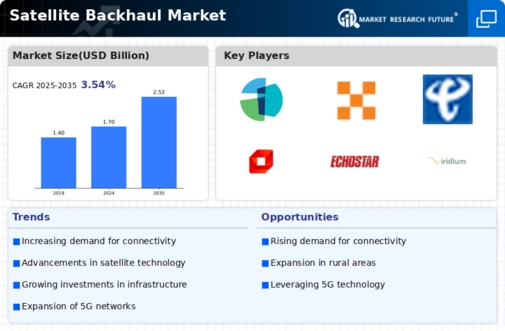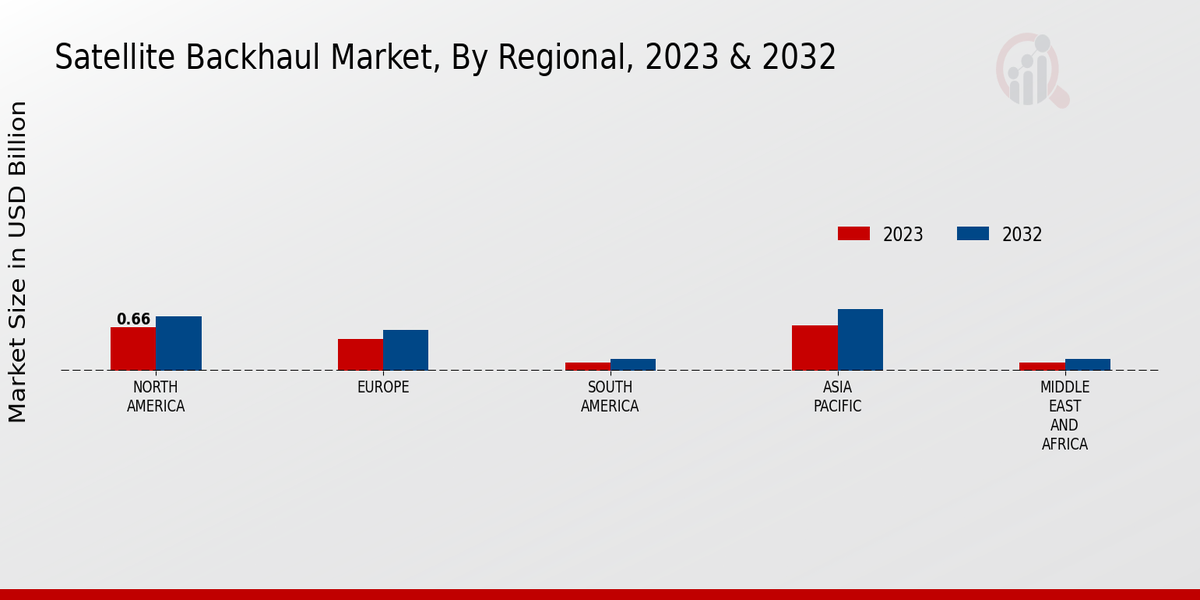Market Growth Projections
The Global Satellite Backhaul Market Industry is projected to experience substantial growth in the coming years. The market is expected to reach 1.7 USD Billion in 2024 and is anticipated to grow to 2.52 USD Billion by 2035. This growth trajectory indicates a compound annual growth rate (CAGR) of 3.61% from 2025 to 2035. Factors contributing to this growth include rising demand for connectivity, technological advancements, increased investment in infrastructure, and regulatory support. As the global landscape evolves, the satellite backhaul market is poised to play a pivotal role in enhancing communication capabilities across various sectors.
Technological Advancements
Technological advancements play a crucial role in shaping the Global Satellite Backhaul Market Industry. Innovations in satellite technology, such as high-throughput satellites (HTS) and low Earth orbit (LEO) systems, enhance the efficiency and capacity of satellite backhaul services. These advancements enable faster data transmission and improved service quality, attracting more customers and businesses to adopt satellite solutions. As a result, the market is expected to grow to 2.52 USD Billion by 2035, indicating a strong trajectory fueled by ongoing technological improvements. The integration of advanced technologies not only increases operational efficiency but also reduces costs, making satellite backhaul a more viable option for various applications.
Rising Demand for Connectivity
The Global Satellite Backhaul Market Industry experiences a surge in demand for connectivity, particularly in remote and underserved regions. As urbanization continues to expand, the need for reliable communication infrastructure becomes paramount. Satellite backhaul solutions provide an effective means to bridge the digital divide, enabling internet access in areas where terrestrial networks are inadequate. This trend is underscored by the projected market value of 1.7 USD Billion in 2024, reflecting the increasing reliance on satellite technology to meet connectivity needs globally. Governments and organizations are investing in satellite backhaul to enhance communication capabilities, thereby driving market growth.
Increased Investment in Infrastructure
The Global Satellite Backhaul Market Industry benefits from increased investment in infrastructure, particularly in developing regions. Governments and private entities are recognizing the importance of robust communication networks to support economic growth and social development. Investments in satellite backhaul infrastructure facilitate the deployment of essential services such as telemedicine, e-learning, and remote work solutions. This trend is likely to contribute to a compound annual growth rate (CAGR) of 3.61% from 2025 to 2035, as more stakeholders seek to enhance connectivity through satellite solutions. The focus on infrastructure development is expected to create a favorable environment for the expansion of satellite backhaul services globally.
Regulatory Support and Policy Initiatives
Regulatory support and policy initiatives significantly influence the Global Satellite Backhaul Market Industry. Governments worldwide are implementing policies that promote the use of satellite technology to enhance communication infrastructure. These initiatives often include funding for satellite projects, spectrum allocation, and incentives for private sector participation. Such regulatory frameworks create a conducive environment for the growth of satellite backhaul services, encouraging investment and innovation. As countries strive to improve connectivity and digital inclusion, the role of satellite backhaul becomes increasingly vital. This supportive regulatory landscape is expected to propel market growth, aligning with global efforts to enhance communication capabilities.
Growing Demand for Mobile Backhaul Solutions
The Global Satellite Backhaul Market Industry is witnessing a growing demand for mobile backhaul solutions, driven by the proliferation of mobile devices and the increasing need for high-speed internet. As mobile network operators seek to enhance their service offerings, satellite backhaul provides a reliable solution for connecting remote cell sites and expanding coverage. This trend is particularly relevant in regions with challenging terrain or limited terrestrial infrastructure. The integration of satellite backhaul into mobile networks allows operators to improve service quality and customer satisfaction, thereby supporting market growth. The ongoing expansion of mobile networks globally further underscores the importance of satellite backhaul in meeting connectivity demands.






















